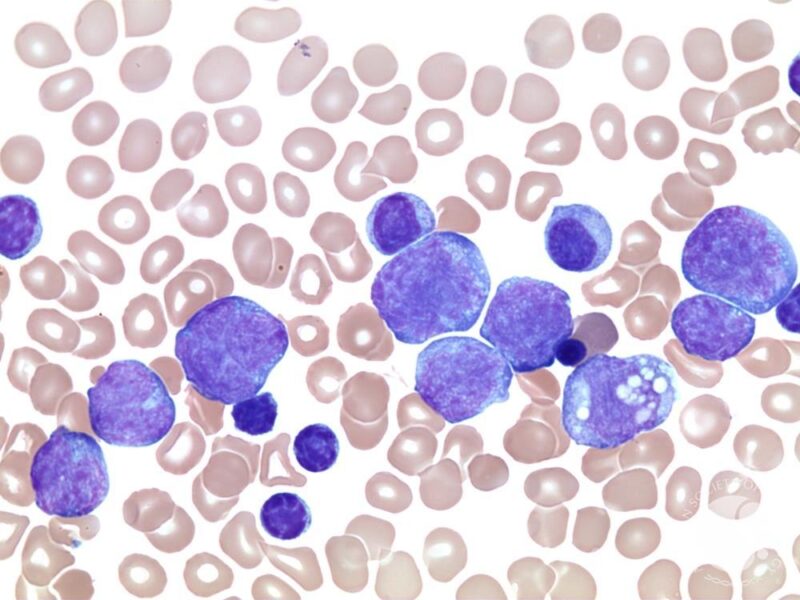
Delineating the Role of Mitochondrial Dysregulation in Richter’s Transformation
Chronic lymphocytic leukemia (CLL) is a mature B cell disease identified by the aberrant expression of CD5. Richter’s transformation (RT) is a rare and aggressive progression of CLL, with a median survival of less than a year. The mechanisms driving this transformation are still not fully understood. Common genomic alterations in CLL include deletions in chromosome 13q and mutations in SF3B1. MYC alterations are acquired in 40-60% of cases transitioning from CLL to RT.
Recent genome sequencing of paired CLL-RT samples revealed loss-of-function mutations in MGA in approximately 30% of RT cases, compared to just 4% in CLL cases. To explore this further, researchers developed a B-cell restricted CLL to RT murine model using CRISPR-Cas9 to engineer loss-of-function MGA mutations in early progenitors, along with common CLL mutations like the 13q deletion (minimal deleted region-Mdr) and SF3B1-K700E. This model exhibited increased cell size, elevated MYC and Ki67 levels, loss of CD5 expression, and features mimicking human RT. Serial transplantations in both immunocompetent and immunocompromised mice showed similar RT disease profiles.
RNA sequencing of murine splenic RT cells revealed increased oxidative phosphorylation (OXPHOS) and MYC signatures. These altered OXPHOS signatures were accompanied by changes in mitochondrial structure, leading to increased cellular reactive oxygen species (ROS) in RT, which can trigger oncogenic signaling. NME1 (Nucleoside diphosphate kinase), identified as an MGA and MYC target from RNA-seq analysis, was validated by western blot in murine RT samples and immunohistochemistry in primary RT samples. MGA knockout in cell lines, resulted in upregulating OXPHOS complex II, increased oxygen consumption rate regulated by NME1.
As NME1 lacks commercial inhibitors, researchers tested CDK9 inhibitors (AZ5576-targeting MYC) and complex II inhibitors (TTFA – Thenoyltrifluoroacetone) in cell lines. TTFA and CDK9 inhibitors significantly reduced MYC and NME1 levels and decreased mTOR signaling in cell lines. In vivo studies showed that these inhibitors prolonged the survival of RT mice, suggesting potential therapeutic targets.
This study highlights the MGA/MYC/NME1 axis as a driver of RT through increased mitochondrial OXPHOS and ROS accumulation, opening new avenues for developing targeted therapies to treat RT more effectively.

“MGA deletion leads to Richter’s transformation by modulating mitochondrial OXPHOS”
Authors: Prajish Iyer, Bo Zhang, Tingting Liu, Meiling Jin, Kevyn Hart, Jibin Zhang, Viola Siegert, Marianne Remke, Xuesong Wang, Lei Yu, Joo Song, Girish Venkataraman, Wing C. Chan, Zhenyu Jia, Maike Buchner, Tanya Siddiqi, Steven T. Rosen, Alexey Danilov and Lili Wang.

Prajish Iyer, First Author of the Article, is currently a Staff Scientist in the Department of Systems Biology at City of Hope in Duarte, California. He was awarded his PhD in life sciences from Tata Memorial Cancer Centre, Advanced Center for Treatment Research and Education in Cancer (ACTREC) in India. Dr. Iyer moved to the United States for his postdoctoral fellowship at City of Hope, where he was soon promoted to staff scientist and joined the laboratory of Lili Wang. His area of research focus has been to understand the molecular mechanisms of genetic alterations in CLL / SLL and to better understand changes that occur at the cellular level in those whose cancer progresses to RT.
Lili Wang, Corresponding Author and mentor, is a Professor in the Department of Systems Biology. Dr. Wang obtained her M.D. at the China Medical University (Shenyang, China) and her Ph.D. degree at the Tokai University (Isehara, Japan). In 2017, Dr. Wang joined the Department of Systems Biology at the Beckman Research Institute. She is also a member of the Toni Stephenson Lymphoma Center at City of Hope.
Dr. Wang’s group studies genetic alterations, RNA splicing dysregulation and oncogenesis in hematologic malignancies. The laboratory focuses on understanding how splicing factor mutations and RNA epigenetics dysregulation contributing to splicing dysregulation and lymphoma biology with chronic lymphocytic leukemia and mantle cell lymphoma as disease models. The ultimate goal is to discover novel prognostic markers and to design better therapeutic approaches.
Why Is Research About Mitochondrial Dysregulation in Richter’s Transformation Needed?
Mitochondria are parts within a cell that serve as the powerhouse that provides the energy for everything to run smoothly. But in RT cells, the mitochondria abnormally mutate and stop working correctly. When the mitochondria change and adapt, it allows the cancerous cells to have a survival advantage and replicate abnormally.
By understanding exactly how the shift in energy takes place within the mitochondria, Dr. Iyer hopes to then be able to find ways to make it more difficult for these cells to survive and spread out of control by blocking certain survival pathways within the cells. Targeting these identified survival pathways within the mitochondria could be a promising strategy for disrupting the very foundation of RT cell survival by limiting the ability of the cancerous CLL / SLL cells to adapt and grow.
